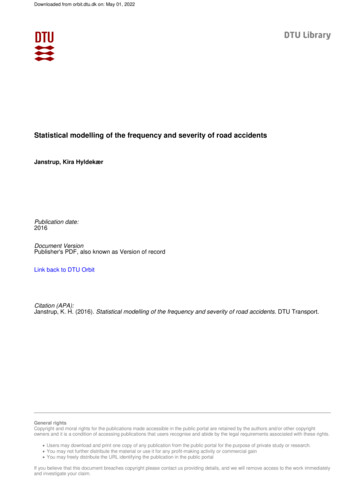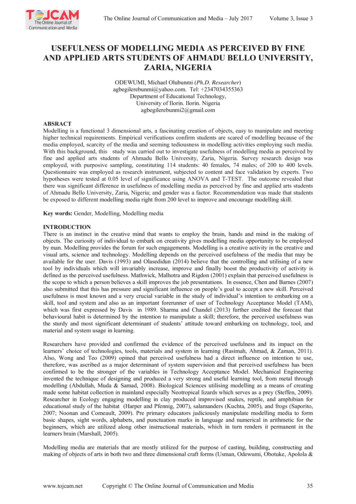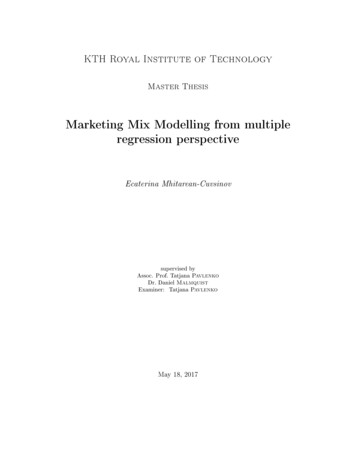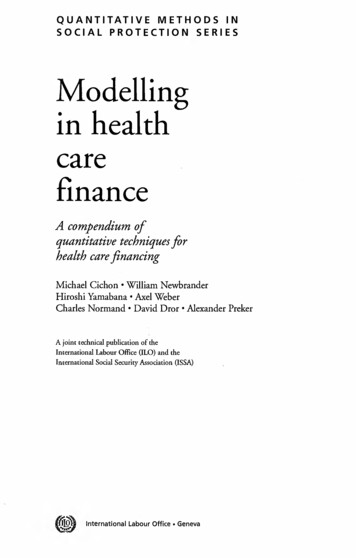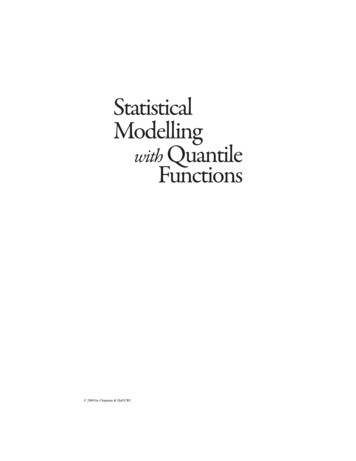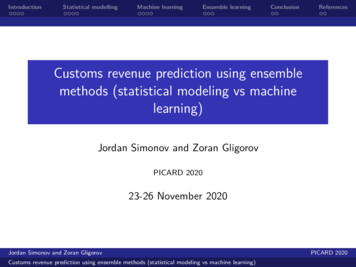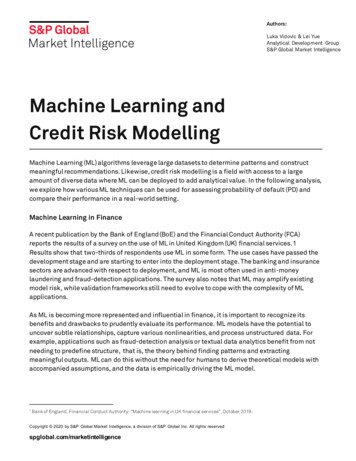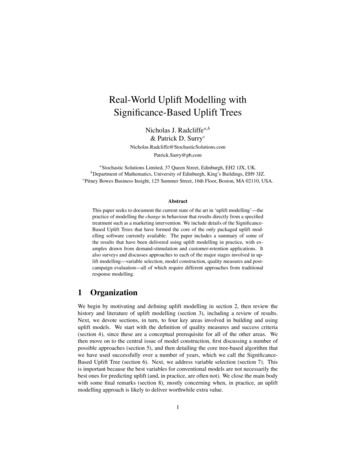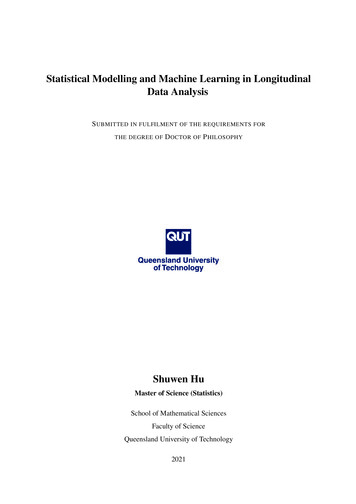
Transcription
Statistical Modelling and Machine Learning in LongitudinalData AnalysisS UBMITTED IN FULFILMENT OF THE REQUIREMENTS FORTHE DEGREE OFD OCTOR OF P HILOSOPHYShuwen HuMaster of Science (Statistics)School of Mathematical SciencesFaculty of ScienceQueensland University of Technology2021
Copyright in Relation to This Thesisc Copyright 2021 by Shuwen Hu. All rights reserved. Statement of Original AuthorshipThe work contained in this thesis has not been previously submitted to meet the requirementsfor an award at this or any other higher education institution. To the best of my knowledge andbelief, the thesis contains no material previously published or written by another person exceptwhere due reference is made.Signature:Date:QUT Verified Signature17/05/2021i
ii
To my familyiii
iv
AbstractThis thesis mainly focuses on statistical modelling and machine learning in longitudinal dataanalysis. Longitudinal data analysis often assumes that observations are correlated on the samesubjects or clusters and independent among different subjects or clusters. Recently, there hasbeen interest in the applied and methodological analysis of longitudinal data. To approach thecorrelations in longitudinal data, the current thesis focuses on two popular statistical modellingmethods: the linear mixed model (LMM) and generalised estimating equations (GEE). Treebased methods, the support-vector machine (SVM) and neural network (NN) methods are themachine learning methods discussed in this thesis.First, GEE is a widely used method for analysing longitudinal data, and the sandwichmethod is often used to estimate the variance-covariance matrix of the regression coefficientestimators because it is robust against the misspecification of the correlation structure of the responses. However, the sandwich method relies on the inner product of residuals as an estimatorfor the true covariance of the responses, and this estimator becomes singular and sparse as thecluster size becomes larger. Our focus is to investigate whether the sandwich estimator and itsmodified versions are still valid when a sparse or singular matrix is used as an estimate of thetrue covariance of the responses.The second main interest of this study is to investigate the performance of predictive responses in longitudinal data with LMM and six different machine learning methods: trees,bagging, the random forest, boosting, the SVM and the neural network. The tree method ofcombined random effects (RE-EM trees) is also included in the comparison. Indeed, statisticalmodels have better performance than these machine learning methods when the mean functionof models can be correctly specified.The last part of the thesis explores the features derived from a mixture of time-windowsizes, which can improve the classification accuracy of machine learning algorithms for sheepv
behaviours. Preliminary analysis indicates that the time-window size of segmented signal datacan significantly affect the classification accuracy of animal behaviours. Three machine learningalgorithms, the random forest (RF), the SVM and the linear discriminant analysis (LDA) wereapplied to investigate the ability of these different approaches to classify sheep behaviour accurately. The results clearly show that the simultaneous inclusion of features derived from mixedtime-window sizes significantly improved the behaviour classification accuracy, in contrast tothose determined from a single unique time window size. Importantly, using features derivedfrom time windows of different length may provide the context needed to accurately identifycertain behaviours.vi
PrefaceDeclaration by authorI declare that the thesis has been composed by myself and that the work has not be submittedfor any other degree or professional qualification. I confirm that the work submitted is my own,except where work which has formed part of jointly-authored publications has been included.My contribution and those of the other authors to this work have been explicitly indicated below.I confirm that appropriate credit has been given within this thesis where reference has been madeto the work of others.Publications during candidaturePublishedHu, S., Wang, Y.-G., Fu, L. (2021). Performance of variance estimators in the analysis oflongitudinal data with a large cluster size. Accepted by Journal of Statistical Computation andSimulation. , S., Ingham, A., Schmozlzl, S., McNally, J., Little, B., Smith, D., Bishop-Hurley, G.,Wang, Y.-G., Li, Y. (2020). Inclusion of features derived from a mixture of time window sizesimproved classification accuracy of machine learning algorithms for sheep grazing behaviours.Computers and Electronics in Agriculture, 179, 105857.Hu, S., Xu, J. (2020). An efficient and robust inference method based on empirical likelihoodin longitudinal data analysis. Communications in Statistics-Theory and Methods, 1-17.Wang, N., Wang, Y.-G., Hu, S., Hu, Z., Xu, J., Tang, H., Jin, G. (2018). Robust regression withdata-dependent regularization parameters and autoregressive temporal correlations in environmental data analysis. Environmental Modelling & Assessment, 23(6), 779-786.Under reviewvii
Hu, S., Wang, Y.-G., Drovandi, C., Cao, T. (2021). Machine learning with mixed-effects inanalyzing longitudinal data. Submitted for publication.Then the contributions of the PhD candidate and the co-authors to each of publications includedin this thesis are presented.Chapter 3: Performance of variance estimators in the analysis of longitudinal data with alarge cluster sizeThe reference for the publication associated with this chapter is:Hu, S., Wang, Y.-G., Fu, L. (2021). Performance of variance estimators in the analysis oflongitudinal data with a large cluster size. Accepted by Journal of Statistical Computation andSimulation.Table 1: Statement of contribution for chapter 3ContributorStatement of contributionShuwen Hu (Can- Wrote the manuscript, experimental design, conduct experiments, datadidate)analysis, revised the manuscript as suggested by co-authors and referees.You-Gan WangInitiated the research concept, supervised research.Liya FuAided experimental design, supervised research, comments on themanuscript.Chapter 4: Machine learning with mixed-effects in analyzing longitudinal dataThe reference for the publication associated with this chapter is:Hu, S., Wang, Y.-G., Drovandi, C., Cao, T. (2021). Machine learning with mixed-effects inanalyzing longitudinal data. Submitted for publication.Chapter 5: Inclusion of features derived from a mixture of time window sizes improvedclassification accuracy of machine learning algorithms for sheep grazing behavioursThe reference for the publication associated with this chapter is:Hu, S., Ingham, A., Schmozlzl, S., McNally, J., Little, B., Smith, D., Bishop-Hurley, G.,Wang, Y.-G., Li, Y. (2020). Inclusion of features derived from a mixture of time window sizesviii
Table 2: Statement of contribution for chapter 4ContributorStatement of contributionShuwen Hu (Can- Wrote the manuscript, experimental design, conduct experiments, datadidate)analysis, revised the manuscript as suggested by co-authors.You-Gan WangInitiated the research concept, supervised research.Christoper Drovandi Aided experimental design, supervised research, comments on themanuscript.Taoyun CaoRevised manuscript, advised on interpretation of results.improved classification accuracy of machine learning algorithms for sheep grazing behaviours.Computers and Electronics in Agriculture, 179, 105857.Table 3: Statement of contribution for chapter 5ContributorShuwen Hu (Candidate)Aaron InghamSabine SchmoelzlJody McNallyBryce LittleDaniel SmithGreg H.-BishopYou-Gan WangYutao LiStatement of contributionMethodology development, investigation, original draft writing, revisedas suggested by co-authors and referees.Conceptualisation, Supervision, reviewing and editing.Data curation and editing.Sensor deployment and annotation.Annotation dology development, supervision.Conceptualisation, supervision, writing, reviewing and editing.ix
x
AcknowledgmentsPhD learning is a journey and a lot of people have helped me during this time in Brisbane. NowI wish to express my gratitude to those people.First, I would like to thank my principal supervisor Professor You-Gan Wang for his guidance and expertise throughout this journey. I really appreciate his time and effort in supervisingme. His ideas always impress me and inspire me to learn more. I am grateful to my associatesupervisor Professor Christopher Drovandi for his encouragement and support. Whenever Iwas in low spirits, I would remember how he had said that was the enthusiasm for research thatwould wake him up in the morning.I am grateful to have worked with Dr Aaron Ingham, Dr Yutao Li and other co-authors fromthe Commonwealth Scientific and Industrial Research Organisation in Australia. My thanks tothem, without whom this work would not have been possible.I wish to thank the Queensland University of Technology and the Australian Centre ofExcellence for Mathematical and Statistical Frontiers (ACEMS) for providing financial support.Special thanks go to ACEMS for providing a convenient studying environment. I would alsolike to thank all my friends and the ACEMS members for their help and for everything that Ihave shared with and learned from them. I would like to thank Heather Morris for the carefulproof reading of my thesis.Finally, I wish to thank my parents for their unwavering support and continuous love. I amincredibly grateful to my partner Mang Xu for his understanding, encouragement and company.He is always there by my side and teaches me what is important. The Master said: ‘I am not one who was born in the possession of knowledge; I am onewho is fond of antiquity, and earnest in seeking it there.’ (Analects of Confucius: 7.20)xi
xii
Table of laturexviiList of FiguresxxiiList of Tablesxxiv12Introduction11.1Overview . . . . . . . . . . . . . . . . . . . . . . . . . . . . . . . . . . . . .11.1.1Longitudinal data . . . . . . . . . . . . . . . . . . . . . . . . . . . . .11.1.2Statistical modelling . . . . . . . . . . . . . . . . . . . . . . . . . . .21.1.3Machine learning . . . . . . . . . . . . . . . . . . . . . . . . . . . . .41.2Objectives and research questions . . . . . . . . . . . . . . . . . . . . . . . .61.3Thesis structure . . . . . . . . . . . . . . . . . . . . . . . . . . . . . . . . . .8Literature Review112.1Longitudinal data analysis . . . . . . . . . . . . . . . . . . . . . . . . . . . .112.1.1Generalised estimating equations . . . . . . . . . . . . . . . . . . . .122.1.2Linear mixed-effects models (LMMs) . . . . . . . . . . . . . . . . . .17xiii
2.23182.2.1Linear discriminant analysis . . . . . . . . . . . . . . . . . . . . . . .192.2.2Tree-based methods . . . . . . . . . . . . . . . . . . . . . . . . . . .202.2.3Support-vector machine . . . . . . . . . . . . . . . . . . . . . . . . .222.2.4Neural networks . . . . . . . . . . . . . . . . . . . . . . . . . . . . .272.2.5Mixed-effects machine learning . . . . . . . . . . . . . . . . . . . . .27Performance of Variance Estimators in Analysis of Longitudinal Data with a LargeCluster Size313.1Introduction . . . . . . . . . . . . . . . . . . . . . . . . . . . . . . . . . . . .323.2Covariance estimators . . . . . . . . . . . . . . . . . . . . . . . . . . . . . . .343.2.1Sandwich estimator . . . . . . . . . . . . . . . . . . . . . . . . . . . .353.2.2Modified sandwich estimator . . . . . . . . . . . . . . . . . . . . . . .353.2.3Regularised sandwich estimator . . . . . . . . . . . . . . . . . . . . .373.2.4Smooth bootstrap . . . . . . . . . . . . . . . . . . . . . . . . . . . . .38Simulation studies . . . . . . . . . . . . . . . . . . . . . . . . . . . . . . . . .393.3.1Simulation setup . . . . . . . . . . . . . . . . . . . . . . . . . . . . .393.3.2Simulation results . . . . . . . . . . . . . . . . . . . . . . . . . . . .40Data analysis example . . . . . . . . . . . . . . . . . . . . . . . . . . . . . .413.4.1Berkeley growth study data . . . . . . . . . . . . . . . . . . . . . . . .413.4.2Protein of milk data. . . . . . . . . . . . . . . . . . . . . . . . . . .46Discussion . . . . . . . . . . . . . . . . . . . . . . . . . . . . . . . . . . . . .503.33.43.54Machine learning methods . . . . . . . . . . . . . . . . . . . . . . . . . . . .Machine Learning with Mixed-effects in Analyzing Longitudinal Data554.1Introduction . . . . . . . . . . . . . . . . . . . . . . . . . . . . . . . . . . . .564.2Models . . . . . . . . . . . . . . . . . . . . . . . . . . . . . . . . . . . . . .584.2.1Linear mixed-effects models . . . . . . . . . . . . . . . . . . . . . . .584.2.2Tree-based method . . . . . . . . . . . . . . . . . . . . . . . . . . . .59xiv
4.34.44.554.2.3Mixed-effects regression tree . . . . . . . . . . . . . . . . . . . . . . .614.2.4Support-vector machine . . . . . . . . . . . . . . . . . . . . . . . . .614.2.5Neural network . . . . . . . . . . . . . . . . . . . . . . . . . . . . . .62Simulation studies . . . . . . . . . . . . . . . . . . . . . . . . . . . . . . . . .634.3.1Design of simulations . . . . . . . . . . . . . . . . . . . . . . . . . .634.3.2Simulation results . . . . . . . . . . . . . . . . . . . . . . . . . . . .65Application to real data . . . . . . . . . . . . . . . . . . . . . . . . . . . . . .684.4.1Case study 1: milk protein data . . . . . . . . . . . . . . . . . . . . .684.4.2Case study 2: wages data . . . . . . . . . . . . . . . . . . . . . . . . .70Conclusions and discussion . . . . . . . . . . . . . . . . . . . . . . . . . . . .71Inclusion of Features Derived from a Mixture of Time Window Sizes ImprovedClassification Accuracy of Machine Learning Algorithms for Sheep Grazing Behaviours775.1Introduction . . . . . . . . . . . . . . . . . . . . . . . . . . . . . . . . . . . .795.2Materials and methods . . . . . . . . . . . . . . . . . . . . . . . . . . . . . .815.2.1Experiment design and data collection . . . . . . . . . . . . . . . . . .815.2.2Consolidation of sensor data and ground truth dataset . . . . . . . . . .825.2.3Feature extraction from sensor data . . . . . . . . . . . . . . . . . . .825.2.4Machine learning (ML) algorithms for classification . . . . . . . . . .855.2.5Performance of the classification . . . . . . . . . . . . . . . . . . . . .86Results . . . . . . . . . . . . . . . . . . . . . . . . . . . . . . . . . . . . . . .875.3.1Classification of behaviours using individual unique time window sizes875.3.2Classification of behaviours using mixed time window sizes . . . . . .87Discussion . . . . . . . . . . . . . . . . . . . . . . . . . . . . . . . . . . . . .935.4.1Window size . . . . . . . . . . . . . . . . . . . . . . . . . . . . . . .945.4.2Feature selection . . . . . . . . . . . . . . . . . . . . . . . . . . . . .955.4.3Machine learning methods . . . . . . . . . . . . . . . . . . . . . . . .965.35.4xv
5.56Conclusions . . . . . . . . . . . . . . . . . . . . . . . . . . . . . . . . . . . .97Conclusions and Discussion996.1Summary of the research . . . . . . . . . . . . . . . . . . . . . . . . . . . . .996.2Topics for further research . . . . . . . . . . . . . . . . . . . . . . . . . . . . 101A Example: Analysis for Machine Learning Methods103B Supplementary Material for Chapter 3107C Supplementary Material for Chapter 5123Literature Cited133xvi
NomenclatureAbbreviationsACEMSAustralian Centre of Excellence for Mathematical and StatisticalAdaBoostAdaptive BoostingANNArtificial Neural NetworkAR(1)AugoRegressive model of order 1BRTBoosting Regression treesCARTClassification And Regression TreeCSIROCommonwealth Scientific and Industrial Research OrganisationEMExpectation MaximisationGEEGeneralised Estimating EquationsGLMGeneralised Linear ModelsGMERTGeneralised Mixed-Effects Regression TreesGUIDEGeneralised, Unbiased Interaction Detection and EstimationKKTKarush-Kuhn-TuckerKNNK-Nearest NeighbourLDALinear Discriminant AnalysisLMMLinear Mixed ModelLS-SVMLeast Squares Support Vector MachineMEMSMicroElectroMechanical SystemMERTMixed-Effects Regression TreesMLMaximum Likelihoodxvii
MLMachine LearningMLPMultiLayer PerceptronNLSYNational Longitudinal Survey of YouthNNNeural NetworkNRNewton-RaphsonQDAQuadratic discriminant analysisQUTQueensland University of TechnologyRE-EM treesRandom Effects-Expectation Maximisation treesREMLRestricted Estimation Maximum LikelihoodRFRandom ForestRMSERooted Mean Square ErrorSVCSupport Vector ClassifierSVMSupport Vector MachineSVRSupport Vector RegressionTRMSETrue Rooted Mean Square ErrorVIMVariable Importance Measurexviii
List of Figures1.1Diagrammatic representation of research motivation . . . . . . . . . . . . . . .3.1The ratios of standard error by different methods versus the true standard error8for norm data with sample size 30. The cluster sizes are 5, 10, 20, 30, 50,100, 200, 500 and 1000 separately. M-B: model-based method, LZ: sandwichmethod, WL: method from Wang and Long [2011], W: regularised method fromWarton [2011], B-p: bootstrap method with Poisson distribution . . . . . . . .3.242The ratios of standard error by different methods versus the true standard errorfor Poisson data with sample size 30. The cluster sizes are 5, 10, 20, 30, 50,100, 200, 500 and 1000 separately. M-B: model-based method, LZ: sandwichmethod, WL: method from Wang and Long [2011], W: regularised method fromWarton [2011], B-p: bootstrap method with Poisson distribution . . . . . . . .3.343The ratios of standard error by different methods versus the true standard errorfor binomial data with sample size 30. The cluster sizes are 5, 10, 20, 30, 50,100, 200, 500 and 1000 separately. M-B: model-based method, LZ: sandwichmethod, WL: method from Wang and Long [2011], W: regularised method fromWarton [2011], B-p: bootstrap method with Poisson distribution . . . . . . . .443.4The heights of 54 girls and 39 boys measured at 31 different ages respectively .473.5The protein of milk measured at 19 weeks for three different diets respectively .513.6The mean protein of milk measured at 19 weeks for three different diets respectively . . . . . . . . . . . . . . . . . . . . . . . . . . . . . . . . . . . . . . .514.1The wages data . . . . . . . . . . . . . . . . . . . . . . . . . . . . . . . . . .725.1Location of sensor and its orientation on sheep . . . . . . . . . . . . . . . . . .81xix
5.2a) Operator interface of the annotation tool CSIRO AnnoLOG v. 1.0.23. b)Tabular output of annotated behaviours for animal ID1 . . . . . . . . . . . . .825.3Unbalanced behaviour dataset . . . . . . . . . . . . . . . . . . . . . . . . . .835.4The change of overall accuracy for individual ML methods with different timewindow sizes . . . . . . . . . . . . . . . . . . . . . . . . . . . . . . . . . . .885.5The percentage distribution of four behaviours in the mixed time window data .895.6The list of top 36 features selected by RF . . . . . . . . . . . . . . . . . . . .905.7The overall accuracy, precision, recall and F1 score values from using the different number of top ranked features chosen from RF for behaviour classification 905.8The overall accuracy, precision, recall and F1 score values from the differentnumber of top ranked features chosen from SVM with a linear kernel functionand the mixed time window sizes . . . . . . . . . . . . . . . . . . . . . . . . .5.991The overall accuracy, precision, recall and F1 score values from the differentnumber of top ranked features chosen from SVM with a radial kernel functionand the mixed time window sizes . . . . . . . . . . . . . . . . . . . . . . . . .925.10 The overall accuracy, precision, recall and F1 score values from the differentnumber of top ranked features chosen from LDA with the mixed time windowsizes . . . . . . . . . . . . . . . . . . . . . . . . . . . . . . . . . . . . . . . .93A.1 The summary result from the tree . . . . . . . . . . . . . . . . . . . . . . . . . 104A.2 The error rate of pruning the tree . . . . . . . . . . . . . . . . . . . . . . . . . 105B.1 Boxplots for ratios of standard error by different methods versus the true standard error for normal data with sample size 30. The cluster sizes are 5, 10, 20,30, 50, 100, 200, 500 and 1000 separately. M-B: model-based method, LZ:sandwich method, WL: method from Wang and Long [2011], W: regularizedmethod from Warton [2011], B-p: bootstrap method with Poisson distribution. . 108xx
B.2 Boxplots for ratios of standard error by different methods versus the true standard error for Poisson data with sample size 30. The cluster sizes are 5, 10,20, 30, 50, 100, 200, 500 and 1000 separately. M-B: model-based method, LZ:sandwich method, WL: method from Wang and Long [2011], W: regularizedmethod from Warton [2011], B-p: bootstrap method with Poisson distribution. . 109B.3 Boxplots for ratios of standard error by different methods versus the true standard error for binomial data with sample size 30. The cluster sizes are 5, 10,20, 30, 50, 100, 200, 500 and 1000 separately. M-B: model-based method, LZ:sandwich method, WL: method from Wang and Long [2011], W: regularizedmethod from Warton [2011], B-p: bootstrap method with Poisson distribution. . 110B.4 Boxplots for ratios of standard error by different methods versus the true standard error for Poisson data when number of clusters increased. The clustersizes is 8. There are two independent samples. M-B: model-based method, LZ:sandwich method, P: method from Pan [2001], W: regularized method fromWarton [2011], B-p: bootstrap method with Poisson distribution . . . . . . . . 114B.5 Boxplots for ratios of standard error by different methods versus the true standard error for Poisson data when number of clusters increased. The clustersizes is 8. There are two independent samples. M-B: model-based method, LZ:sandwich method, P: method from Pan [2001], W: regularized method fromWarton [2011], B-p: bootstrap method with Poisson distribution . . . . . . . . 115B.6 Boxplots for ratios of standard error by different methods versus the true standard error for Poisson data when number of clusters increased. The clustersizes is 8. There are four independent samples. M-B: model-based method, LZ:sandwich method, P: method from Pan [2001], W: regularized method fromWarton [2011], B-p: bootstrap method with Poisson distribution . . . . . . . . 116B.7 Boxplots for ratios of standard error by different methods versus the true standard error for Poisson data when number of clusters increased. The clustersizes is 8. There are four independent samples. M-B: model-based method, LZ:sandwich method, P: method from Pan [2001], W: regularized method fromWarton [2011], B-p: bootstrap method with Poisson distribution . . . . . . . . 117xxi
B.8 Boxplots for ratios of standard error by different methods versus the true standard error for Poisson data with the cluster size increased from 4 to 30. Thenumber of cluster size is 20. M-B: model-based method, LZ: sandwich method,P: method from Pan [2001], W: regularized method from Warton [2011], B-p:bootstrap method with Poisson distribution . . . . . . . . . . . . . . . . . . . 118B.9 Boxplots for ratios of standard error by different methods versus the true standard error for Poisson data with the cluster size increased from 4 to 30. Thenumber of cluster size is 20. M-B: model-based method, LZ: sandwich method,P: method from Pan [2001], W: regularized method from Warton [2011], B-p:bootstrap method with Poisson distribution . . . . . . . . . . . . . . . . . . . 119B.10 Boxplots for ratios of standard error by different methods versus the true standard error for Poisson data with the cluster size increased from 4 to 30. Thenumber of cluster size is 20. M-B: model-based method, LZ: sandwich method,P: method from Pan [2001], W: regularized method from Warton [2011], B-p:bootstrap method with Poisson distribution . . . . . . . . . . . . . . . . . . . 120B.11 Boxplots for ratios of standard error by different methods versus the true standard error for Poisson data with the cluster size increased from 4 to 30. Thenumber of cluster size is 20. M-B: model-based method, LZ: sandwich method,P: method from Pan [2001], W: regularized method from Warton [2011], B-p:bootstrap method with Poisson distribution . . . . . . . . . . . . . . . . . . . 121C.1 The list of 36 of the most important features selected by RF based on the leavingone animal out cross-validation scheme . . . . . . . . . . . . . . . . . . . . . 123C.2 The over accuracy, precision, recall and F1 score values from the differentnumber of top ranked features chosen from Random Forest (RF) when usingthe mixed time window approach and leaving one animal out cross-validationscheme . . . . . . . . . . . . . . . . . . . . . . . . . . . . . . . . . . . . . . 124xxii
List of Tables1Statement of contribution for chapter 3 . . . . . . . . . . . . . . . . . . . . . . viii2Statement of contribution for chapter 4 . . . . . . . . . . . . . . . . . . . . . .ix3Statement of contribution for chapter 5 . . . . . . . . . . . . . . . . . . . . . .ix1.1The structure of longitudinal data . . . . . . . . . . . . . . . . . . . . . . . . .22.1EM algorithms for the maximum-likelihood (ML) estimates in LME . . . . . .192.2EM algorithms for the maximum likelihood estimates in MERT . . . . . . . .283.1The mean and deviation of ratios of standard error by different methods versusthe true standard error for norm data with sample size 30 . . . . . . . . . . . .3.2The mean and deviation of ratios of standard error by different methods versusthe true standard error for Poisson data with sample size 303.3. . . . . . . . . .46The mean and deviation of ratios of standard error by different methods versusthe true standard error for binary data with sample size 303.445. . . . . . . . . . .48Parameter estimates with standard errors and length(cm) of 95% confidenceinterval from a Gaussian model with AR(1) correlation structure for growth data 493.5Parameter estimates with standard errors and length of 95% confidence intervalfrom a Gaussian model with AR(1) correlation structure for milk data . . . . .4.1The performances of different methods in simulated data generated from amixed-effects model . . . . . . . . . . . . . . . . . . . . . . . . . . . . . . .4.25266The performances of different methods in simulated data which correlated withthe exchangeable and AR(1) structure . . . . . . . . . . . . . . . . . . . . . .xxiii67
4.3The one-step prediction for different methods in simulated data generated froma mixed-effects model4.4. . . . . . . . . . . . . . . . . . . . . . . . . . . . . .69The one-step prediction for different methods in simulated data which correlated with the exchangeable and AR(1) structure4.668The two-step prediction for different methods in simulated data generated froma mixed-effects model4.5. . . . . . . . . . . . . . . . . . . . . . . . . . . . . . . . . . . . . . . . . . . . .74The two-step prediction for different methods in simulated data which correlated with the exchangeable and AR(1) structure. . . . . . . . . . . . . . . .754.7The RMSE values for different methods in Milk data and Wages data . . . . . .765.1Illustration of deriving average features from mixed time window sizes . . . . .845.2Illustration of calculation of additional features of cumulative effects of X-axisAcceleration magnitude measurement. T: the total number of intervals for agiven time window; t: a particular interval . . . . . . . . . . . . . . . . . . . .5.384Effects of individual time window sizes on the behaviour recognition performance F1-score, when using RF, SVM and LDA. NA - not available . . . . . .88A.1 Breeds included in the analysis . . . . . . . . . . . . . . . . . . . . . . . . . . 103xxiv
Chapter 1Introduction1.1Overview1.1.1 Longitudinal dataRepeated measurements data have become popular in recent years because they frequentlyappear in an increasing number of research areas, such as clinical trial studies, medical scienceand economics [Diggle et al., 2002, Heckman and Singer, 1986]. Using repeated measurementsdata means that there are multiple observations for each different subject. Longitudinal data orpanel data are a special type of repeated measurements data in which multiple observations arecollected over time. There are some advantages of studies with repeated measurements. First,the design of collecting longitudinal data is the only design that can obtain the informationthat concerns the individual pattern of change [Li, 2006]. Second, it requires a smaller numberof subjects and the requisite time and costs can be much lower. Third, the power of analysisincreases because the repeated measure designs control for factors that cause variability betweensubjects. However, there are also some challenges in the analysis of repeated measurementsdata. The main characteristic of longitudinal data is the correlation within the observationsfor each subject, which violates the common assumptions of classical statistical models. Theestimates of the regression parameters are inefficient and the power to detect the differences ininterests is lower when the correlation is ignored. Usually, the number of observations is not thesame for each subject, which is known as unbalanced data. The other common phenomena inthe longitudinal data are the data is incomplete as some patients may fail to be revisited becauseof certain factors relevant or irrelevant to the studies. Therefore, interest in longitudinal data1
CHAPTER 1. INTRODUCTION2analysis has increased and appropriate models and corresponding analysis are needed.We provide an intuitive description of the structure of longitudinal data in Table 1.1.Table 1.1: The structure of longitudinal .x11p.Responsey11.n11.x1n1 1x211.··
Hu, S., Wang, Y.-G., Drovandi, C., Cao, T. (2021). Machine learning with mixed-effects in analyzing longitudinal data. Submitted for publication. Chapter 5: Inclusion of features derived from a mixture of time window sizes improved classification accuracy of machine learning algorithms for sheep grazing behaviours

